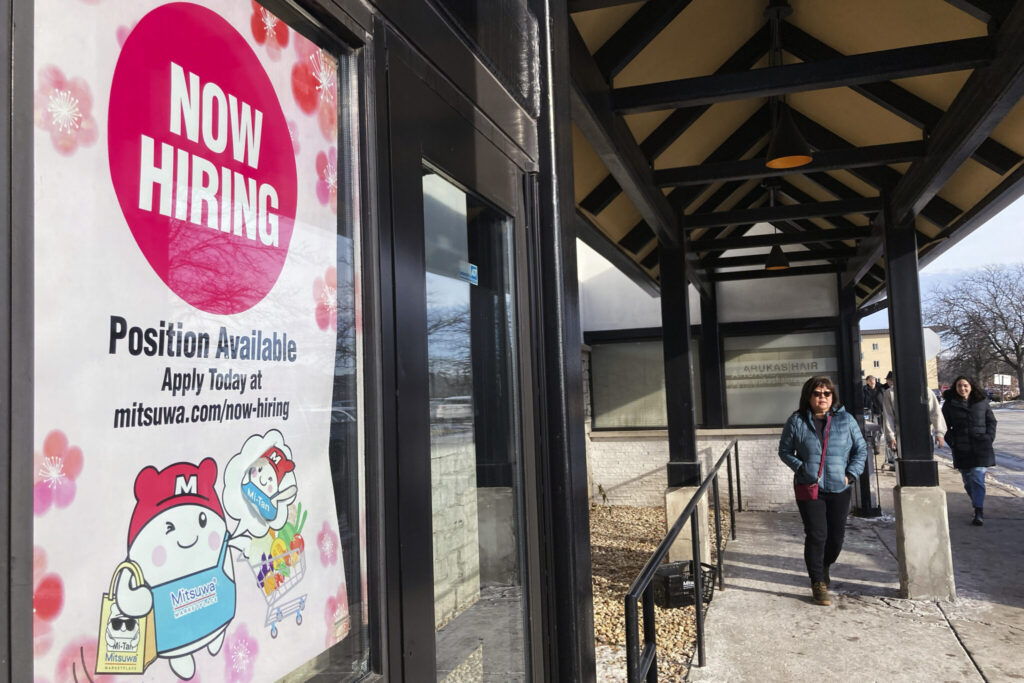The U.S. economy likely maintained a solid pace of job and wage growth in December, but rising borrowing costs as the Federal Reserve fights inflation could slow labor market momentum significantly by mid-year. The Labor Department’s closely watched employment report on Friday is also expected to show the unemployment rate unchanged at 3.7% last month. The labor market has remained strong since the Fed embarked last March on its fastest interest rate-hiking since the 1980s. The Associated Press has the story:
Strong month of hiring would put Fed in tough spot
Newslooks- WASHINGTON (AP)
The jobs report the government will issue Friday is expected to show that December was another healthy month for hiring — a boon for those looking for work but a problem for the Federal Reserve if it persists.
Economists have forecast that employers added 200,000 jobs last month and that the unemployment rate remained at 3.7%, near a half-century low, according to the data provider FactSet.
Last month’s job growth will cap a second strong year of hiring for the U.S. economy. Through November, employers had added 4.9 million jobs in 2022, after 6.7 million were gained in 2021. All that hiring was part of a powerful rebound from the pandemic recession of 2020, a year when 9.3 million jobs were lost.
Last August, roughly two years after the pandemic recession ended, the nation had regained all the jobs lost to COVID-19. By contrast, it took nearly six years to regain the jobs that were lost in the 2008-2009 recession. Most economists credit, in part, the huge federal aid packages, totaling $5 trillion, that were pushed by Presidents Donald Trump and Joe Biden for the sharp rebound.
Yet that government spending and the subsequent job gains also contributed to a swift rise in year-over-year inflation, which reached 9.1%, the highest level in 40 years, in June. Inflation has been slowing since then and amounted to 7.1% in November. Last year, in an aggressive drive to reduce inflation back toward its 2% goal, the Fed raised its benchmark interest rate seven times.
A solid job gain for December would indicate that for now, the economy is mostly healthy and far from falling into a downturn, though many economists expect a recession in the second half of this year.
But another month of brisk hiring would also make the Fed’s delicate task even harder. The central bank is trying to curb inflation by making borrowing and spending increasingly expensive for consumers and businesses without causing a recession in the process.
Fed Chair Jerome Powell has emphasized in recent remarks that consistently strong job growth, which can force employers to raise pay to find and keep workers, can perpetuate inflation: Companies often raise prices to pass on their higher labor costs to their customers. And higher pay typically fuels more consumer spending, which can keep inflation elevated.
For that reason, Powell and other Fed officials have signaled their belief that to get inflation under control, unemployment will have to rise from its current low level.
“The more the goal of higher unemployment appears to be slipping away from the Fed, the more aggressive it needs to be,” said Tim Duy, chief U.S. economist at SGH Macro Advisors.
Fed officials have projected that they will raise their benchmark short-term rate to about 5.1% this year, the highest level in more than 15 years. If hiring and inflation remain strong, the Fed’s rate might have to move even higher.
Technology companies have been laying off workers for months, with some, including Amazon, saying that they had hired too many people during the pandemic. Amazon has boosted its layoffs to 18,000 from an earlier announcement of 10,000. Cloud software provider Salesforce says it will cut 10% of its workers. And Facebook’s parent company Meta says it will shed 11,000.
Smaller tech companies are also being hit. Stitch Fix, the fast fashion provider, said Thursday that it’s cutting 20% of its salaried workers. DoorDash has said it will eliminate 1,250 jobs.
Yet outside of high tech, smaller companies, in particular, are still hiring. According to the payroll processor ADP, companies with more than 500 employees cut jobs in December, while businesses below that threshold added many more workers. And an analysis by investment bank Jefferies showed that small companies were posting a historically high proportion of job openings.
The Fed is concerned about the fast pace of wage growth, which it sees as a reason why inflation is likely to remain high. Average hourly pay is rising at about a 5% pace, one of its highest levels in decades.
Economists think growth likely amounted to a solid annual rate of roughly 2.5% in the final three months of last year. But there are signs it is slowing, and most analysts expect weaker growth in the current first quarter of 2023.
Consumers barely increased their spending in November, held down by modest holiday shopping. And manufacturing activity contracted in December for a second straight month, with new orders and production both shrinking.
And the housing market, an important economic bellwether, has taken a severe hit from the Fed’s rate hikes, which have more than doubled mortgage rates in the past year. Home sales have plummeted for the past 10 months.







